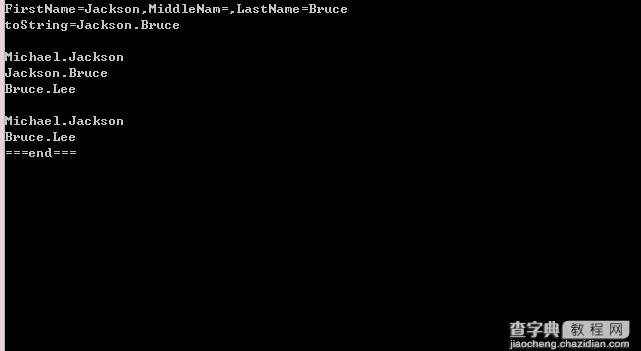本文较为详细的描述了重载运算符的方法。一般来说,重载运算符在实际的项目开发中会经常的用到,但如果某些自定义类型通过简短几行代码重载一些常用的运算符(如:+-*/),就能让编程工作带来方便;重载运算符就是告诉编译器+-*/等运算符对于自定义类型进行什么样的操作,在代码中需要注意几点。
一、尽可能的不要改变运算符本身的含义
二、所有的运算符重载都必须声明为public和static
三、不同于扩展方法,所重载的方法必须是在被重载的类型内部,且用关键字operator
C#中的两个字符串相加,实际上是连接两个字符串,假如有两个EmployeeDetail类型相加得到一个EmployeeCollection集合,如:
EmployeeDetail a,b; .... EmployeeCollection collection = a+b;
当编译器遇到上面的代码时就会自动调用EmployeeDetail类上标有operator +的静态方法,并将两个操作数a和b作为参数传递给对于的方法,该方法需要方法一个值赋给collection,假设EmployeeDetail类有三个属性分别是FirstName,MiddleName,LastName,还重写了ToString方法返回一个连接这三个名称的字符串,代码如:
[Serializable] public class EmployeeDetail { public string FirstName { get; set; } public string MiddleName { get; set; } public string LastName { set;get; } public override string ToString() { return string.Format("{0}{1}{2}{3}{4}", FirstName, string.IsNullOrWhiteSpace(MiddleName) " , MiddleName , string.IsNullOrWhiteSpace(LastName) ", LastName).Trim(); } }
下面的代码为“+”运算符提供支持的运算符重载:
public static EmployeeCollection operator +(EmployeeDetail a, EmployeeDetail b) { return new EmployeeCollection() { a, b }; }
OK,给EmployeeDetail类加上这样的一个方法之后,我们就可以像下面那个写代码了:
EmployeeCollection collection = new EmployeeDetail(){FirstName="Jackson",LastName="Bruce"} + new EmployeeDetail(){FirstName="Michael",LastName="Jackson"} ;
但是这样还不够完美,假设a,b,c都是EmployeeDetail类型,下面的代码会抛出一个编译错误:
EmployeeCollection collection = a + b + c;
为什么编译不通过呢?大家都知道除了赋值运算符外表达式是从左到右执行的,a+b返回的是EmployeeCollection类型,EmployeeCollection类型并没有重载“+”运算符,编译器不知道要执行什么操作,所以我们还有下面的两个方法:
public static EmployeeCollection operator +(EmployeeCollection collection, EmployeeDetail a) { collection.Add(a); return collection; } public static EmployeeCollection operator +(EmployeeDetail a, EmployeeCollection collection) { return collection + a; }
这看起来似乎已经很完美了,但我们还可以做得更好一些,比如要将字符串“Jackson.Bruce”直接隐式转换为EmployeeDetail类型,也就是说可以将“Jackson.Bruce"这种格式的字符串直接赋给EmployeeDetail类型的对象,如:EmployeeDetail employee= “Jackson.Bruce",那么就需要重载隐式类型转换运算符了,代码如下:
/// <summary> /// 隐式类型转换 /// </summary> /// <param name="name"></param> /// <returns></returns> public static implicit operator EmployeeDetail(string name) { /// 其实在这里可以写一个正则表达式检查name的字符串格式是否合法,如果不合法就抛出异常 /// string[] arr; return string.IsNullOrWhiteSpace(name) ? null : new EmployeeDetail() { FirstName = (arr = name.Trim().Split('.'))[0] , LastName = arr.Length > 1 ? arr[arr.Length > 2 ? 2 : 1] : null, MiddleName = arr.Length > 2 ? arr[1] : null }; } public static EmployeeCollection operator +(EmployeeDetail a, string b) { return new EmployeeCollection() { a, b }; }
看到这里您是不是迫不及待地想试试看,OK写个控制台程序来测试一下:
static void Main(string[] args) { EmployeeDetail employee = "Jackson.Bruce"; Console.WriteLine("FirstName={0},MiddleNam={1},LastName={2}", employee.FirstName, employee.MiddleName, employee.LastName); Console.WriteLine("toString={0}", employee); Console.WriteLine(); EmployeeCollection collection = "Michael.Jackson" + employee; collection += "Bruce.Lee"; foreach (var e in collection) { Console.WriteLine(e); } Console.WriteLine(); collection -= employee; foreach (var e in collection) { Console.WriteLine(e); } Console.WriteLine("===end==="); Console.Read(); }
运行结果如下图所示:

全部代码,里面还包含其他运算符的重载,这里就不再介绍了,赶紧动手测试一下吧:
using System; using System.Collections.Generic; using System.Linq; using System.Text; namespace 重载运算符 { [Serializable] public class EmployeeDetail { public string FirstName { get; set; } public string MiddleName { get; set; } public string LastName { set;get; } public static EmployeeCollection operator +(EmployeeDetail a, EmployeeDetail b) { return new EmployeeCollection() { a, b }; } public static EmployeeCollection operator +(EmployeeCollection collection, EmployeeDetail a) { collection.Add(a); return collection; } public static EmployeeCollection operator +(EmployeeDetail a, EmployeeCollection collection) { return collection + a; } /// <summary> /// 隐式类型转换 /// </summary> /// <param name="name"></param> /// <returns></returns> public static implicit operator EmployeeDetail(string name) { string[] arr; return string.IsNullOrWhiteSpace(name) ? null : new EmployeeDetail() { FirstName = (arr = name.Trim().Split('.'))[0] , LastName = arr.Length > 1 ? arr[arr.Length > 2 ? 2 : 1] : null, MiddleName = arr.Length > 2 ? arr[1] : null }; } public static EmployeeCollection operator +(EmployeeDetail a, string b) { return new EmployeeCollection() { a, b }; } public override string ToString() { return string.Format("{0}{1}{2}{3}{4}", FirstName, string.IsNullOrWhiteSpace(MiddleName) " , MiddleName , string.IsNullOrWhiteSpace(LastName) ", LastName).Trim(); } } public class EmployeeCollection : List<EmployeeDetail> { public static EmployeeCollection operator +(EmployeeCollection a, string b) { a.Add(b); return a; } public static EmployeeCollection operator +(string b, EmployeeCollection a) { return a + b; } public static EmployeeCollection operator -(EmployeeCollection a, EmployeeDetail b) { a.Remove(b); return a; } } class Program { static void Main(string[] args) { EmployeeDetail employee = "Jackson.Bruce"; Console.WriteLine("FirstName={0},MiddleNam={1},LastName={2}", employee.FirstName, employee.MiddleName, employee.LastName); Console.WriteLine("toString={0}", employee); Console.WriteLine(); EmployeeCollection collection = "Michael.Jackson" + employee; collection += "Bruce.Lee"; foreach (var e in collection) { Console.WriteLine(e); } Console.WriteLine(); collection -= employee; foreach (var e in collection) { Console.WriteLine(e); } Console.WriteLine("===end==="); Console.Read(); } } }


